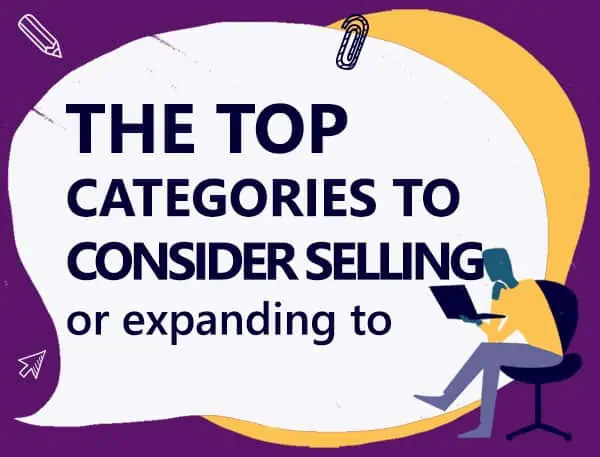What you’ll learn
Do you know your success as an Amazon seller depends on your chosen product category? A wise man once said the riches are in the niches, which is exactly what choosing a category will be in your Amazon business.
In this article, you’ll learn about all the Amazon categories, the top categories, the most profitable product categories on amazon, and how to compete.

Overview of Amazon product categories
Does your product have zero sales? The possibility is that you’re selling in a stagnant category where people don’t buy.
Category selection is crucial if you want to succeed. Here, I’ll discuss the popular categories and what makes a product profitable.
Gated and Ungated Categories on Amazon
When selecting a category, it’s essential to consider if it is gated or ungated. Amazon’s gated categories—such as Beauty and Personal Care, Collectibles, and Fine Art—require special approval, often including additional fees, performance checks, and documentation. These categories may be harder to access but can offer less competition. In contrast, ungated categories are easier to enter, making them accessible to new sellers, though they may also be more saturated.
Amazon All Categories
These are all the categories that Amazon allows 3rd party sellers to use, excluding Amazon devices and services.
| Appliances | Books | Electronics | Industrial & Scientific | Pet Supplies |
| Apps & Games | CDs & Vinyl | Garden & Outdoor | Kindle | Sports & Outdoors |
| Arts, Crafts, & Sewing | Cell Phones & Accessories | Grocery & Gourmet Food | Luggage & Travel Gear | Tools & Home Improvement |
| Automotive Parts & Accessories | Clothing, Shoes and Jewelry | Handmade | Movies & TV | Toys & Games |
| Baby | Collectibles & Fine Art | Health, Household & Baby Care | Musical Instruments | Video Games |
| Beauty & Personal Care | Computers | Home & Kitchen | Office Products |
When should you sell in a popular category on Amazon?
Average monthly sales differ within different product categories on Amazon. Things like consumer electronics or musical instruments is one of the most profitable product categories.
It’s not ideal to sell in popular, best-selling categories unless it is less competitive and not oversaturated. It’s like finding gold if you find something like that.
The realistic thing to do is to find less popular, less saturated subcategories under these popular categories on amazon.
Things to consider when choosing a popular category
According to a Jungle Scout report, the “Home & Kitchen category is the most popular among sellers.” The reason?
- Easy to get into and easy to find products to sell
- Fewer regulations and requirements
- Easy to find suppliers or manufacturers
The catch is that it’s harder for new sellers to launch in this category since most sellers have their private-label products.
Can you compete with Amazon?
Another thing to consider when choosing a popular category is competition with Amazon. A good test is if you search Amazon for a certain item, do you see Amazon products in the results?

Amazon basics products are really basic, so they will usually cost less. Most people will flock to this product because of the low price. Amazon will also push their own products ahead of sellers. They have a monopoly and also take advantage of their own system for their profit.
Fortunately, many people are looking beyond basic products. If you can compete against this, you can profit in this category.
What makes a product profitable on Amazon?
Here are the top 10 categories on amazon:
- Appliances
- Apps & Games
- Arts, Crafts, & Sewing
- Automotive Parts & Accessories
- Baby
- Beauty & Personal Care
- Books
- CDs & Vinyl
- Cell Phones & Accessories
- Clothing, Shoes and Jewelry
Depending on the category, the average net profit margins (not gross profit) for Amazon sellers range from 15% to 26%. Most sellers don’t know how to calculate all the costs and mistake gross profits for net profit.
What are some of the larger profit margins? Handmade goods come first, then certain expensive stuff like computers, appliances, and musical instruments. Quite lucrative as opposed to the video games category.
Remember, those main categories can be less profitable, but sub-categories within them are more profitable. Also, popular niche categories can be less profitable because of competition, making the smaller and less competitive categories more beneficial to an Amazon seller.
Most third-party sellers know to watch out for this when they look at the most popular categories on Amazon.
High-Conversion Product Categories
Categories with high conversion rates, such as Health & Household, Toys & Games, and Beauty & Personal Care, often meet daily consumer needs or have a strong visual appeal. High-conversion categories typically feature products that enjoy high demand, low return rates, or recurring purchases, making them ideal for Amazon sellers focused on generating consistent sales.
Amazon most popular categories
Here are the most popular Amazon categories with higher profit margins.
| Top 10 categories | Avg Profit Margin |
| Home & Kitchen | 32% |
| Beauty & Personal Care | 23% |
| Toys & Games | 20% |
| Clothing, Shoes & Jewelry | 18% |
| Health, Household & Baby Care | 17% |
| Sports & Outdoors | 16% |
| Arts, Crafts & Sewing | 15% |
| Books | 15% |
| Kitchen & Dining | 14% |
| Baby | 14% |
How to find less competitive categories
The best method is to find a niche within a niche in many online marketplaces in the retail industry is to find less competitive categories. Health and fitness is a gigantic category. Either find other categories or niche down to yoga, you’ll find that it’s still a huge category. A better niche could be “yoga pants for new mothers.”
Here’s a better way to find best-selling products in a niche without guesswork.
Use Google search
There are two ways you can do this, through keyword research using “suggested results” and the “people also asked” section.
The first one involves going to google and typing your keyword. Wait for a dropdown of suggested topics, and you might find something interesting that people are searching for.

In this example, I typed in yoga pants and got many results. I think the most interesting result is “yoga pants with pockets.” You can further explore this using another Google or Amazon search.
The second method is typing in your keyword into Google and hitting enter. This time I entered “yoga pants with pockets” and checked the “people also asked” section of the search result.

A good result is product related. Click the dropdown from “What are the pockets in yoga pants for?” and you’ll see that it’s a feature that yoga practitioners are looking for. Search “yoga pants with one pocket,” and you’ll see many products you can take inspiration from.
Social Media – FB, Instagram, Quora, Reddit, etc.
Social media is a mess, but we can’t underestimate the power of communities. Check out individual accounts, groups, and pages to see what people currently discuss.
It’s different for each platform, but all you need to do is actively read and use search. This way, you can know what people want in a niche product.
Use 3rd party websites or use Amazon search
We’re not fans of niche-finding 3rd party apps or websites, but there are services like Jungle Scout that can help you find a profitable niche.
In our case, we use Amazon search and see what sectors are underserved. We also ensure that there are no top-selling products in that category and little competition.
How to Find Best-Selling Products on Amazon
Finding best-selling products on Amazon is essential for identifying profitable opportunities. Use tools like Amazon’s Best Sellers and Movers & Shakers lists to spot trending items, and review top-selling products in each category. Analyzing reviews and customer feedback can also provide insight into popular features and pain points, helping you target unmet needs in the market.
How many product categories are there on Amazon?
There are 25,000 sub-categories on Amazon. Fortunately, Seller central lists the relevant selling categories that people can use. When you create a new listing, you’ll see this in your professional seller account.

Amazon All Categories – Now you know
There are multiple categories to choose from, but we learned that popular doesn’t always mean profitable. Sellers should look for less popular categories within categories to apply innovative marketing tactics, and find high-selling items, less competition, and a decent profit margin.
Comments
Related Posts

10 Profitable Product Categories for Amazon Affiliates 2025
What you’ll learn Amazon is a favorite for experienced and…

Unlock the Secret to a Profitable Automated Amazon Store: How to Build a Hands-Free Income Stream
Ever dreamed of running a profitable Amazon business while sipping…

Master Amazon New Restricted Keywords: A Seller’s Guide to Success
Changes to Amazon’s restricted keywords list have taken a lot…







Leave a Reply